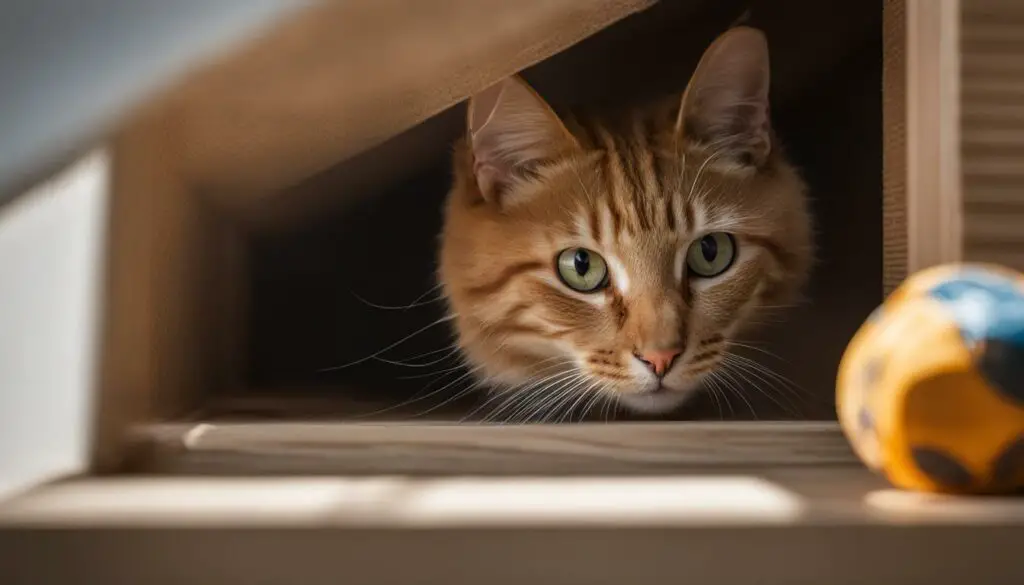Bringing home a new cat is an exciting time, but it’s important to understand their behavior, especially when they start meowing in their safe room. Cats use meowing as a way to communicate, but excessive meowing can indicate various things, such as anxiety, hunger, or a desire to explore their new environment. By keeping them in a safe room initially, you can help them feel secure and give them time to acclimate to their new surroundings.
Key Takeaways:
- Meowing is a way for cats to communicate, but excessive meowing may indicate underlying issues.
- Keeping your new cat in a safe room initially helps them feel secure and adjust to their new home.
- There are several reasons why cats meow in a safe room, including anxiety, hunger, or a desire to explore.
- Introducing a new cat to their new home should be done gradually and with patience.
- Monitoring your new cat’s behavior and providing a calm and comfortable environment will help them adjust more easily.
Why Your New Cat Keeps Meowing in a Safe Room
Understanding why your new cat keeps meowing in a safe room is essential for providing the right care and support. Cats meow as a means of communication, but excessive meowing can indicate underlying issues. Let’s explore some common reasons why your new cat may be meowing in a safe room.
1. Anxiety and Uncertainty: Cats are creatures of habit, and a new environment can be overwhelming for them. Meowing can be a sign of anxiety or uncertainty as they navigate unfamiliar surroundings. Keeping them in a safe room initially helps them feel secure and gradually adjust to their new surroundings.
2. Hunger and Thirst: Another reason your new cat may be meowing in a safe room is hunger or thirst. They may be used to a different feeding schedule or still adjusting to the new routine. Ensure you provide them with fresh food and water, and gradually establish a feeding schedule to address their needs.
“Meowing in a safe room can be a sign of anxiety, hunger, or a desire to explore their environment.”
3. Desire to Explore: Cats are naturally curious creatures, and being confined to a safe room may prompt them to meow in anticipation of exploring their new surroundings. It’s important to gradually introduce them to other areas of the house once they feel more comfortable in the safe room.
| Reasons for Meowing in a Safe Room | Explanation |
|---|---|
| Anxiety and Uncertainty | Cats may meow when feeling anxious or uncertain in a new environment. |
| Hunger and Thirst | A new cat may meow in a safe room if they are hungry or thirsty, as they adjust to the new feeding routine. |
| Desire to Explore | Cats are naturally curious and may meow in anticipation of exploring their new surroundings beyond the safe room. |
Creating a Safe Space for a New Cat
When bringing a new cat into your home, it is important to create a safe space where they can feel secure and settle in at their own pace. This safe room provides them with a controlled environment, free from potential stressors, and allows them to acclimate to their new surroundings.
By confining the new cat to a specific room, you are giving them space to explore and adjust without feeling overwhelmed. This room should be equipped with their essential needs such as food, water, a litter box, and a cozy bed. Adding familiar items like toys or blankets from their previous environment can also help provide comfort and familiarity.
By creating a safe space for your new cat, you are not only ensuring their physical well-being but also their emotional well-being. This controlled environment allows them to feel more secure, reducing the chances of fear or anxiety. It also provides an opportunity for them to gradually become familiar with the scents and sounds of their new home, easing the transition process.
| Benefits of a Safe Room for a New Cat: |
|---|
| 1. Security: Having a designated safe room allows the cat to feel secure in their new environment. |
| 2. Acclimation: The safe room gives the cat time to adjust and become familiar with their new surroundings. |
| 3. Controlled Introduction: It provides a controlled environment for gradually introducing them to other pets in the household, preventing potential conflicts. |
| 4. Reduced Stress: By minimizing exposure to unfamiliar spaces and stimuli, the safe room helps reduce stress and anxiety for the new cat. |
Creating a safe space for your new cat is an essential step in ensuring their successful transition into your home. By providing them with a secure and controlled environment, you are setting the foundation for a positive and comfortable living experience for both you and your new feline friend.
Tips When Introducing a New Cat to Your Home
Introducing a new cat to your home can be an exciting time, but it’s important to approach the process with patience and care. Here are some tips to help calm your new cat and ensure a smooth transition:
- Create a safe and comfortable space: Set up a separate room for your new cat, complete with food, water, litter box, and a cozy bed. This will give them a sense of security and help them adjust to their new surroundings.
- Gradual introduction: Allow your new cat to explore their safe room at their own pace. Spend time with them, talking softly and offering gentle strokes, but avoid overwhelming them with too much attention. Let them come to you when they feel ready.
- Scent swapping: To help your new cat become familiar with the scents of their new environment, exchange bedding or toys between the safe room and other areas of the house where they will eventually have access. This will help them feel more comfortable when it’s time to explore.
Socialization:
Socialization is an important part of introducing a new cat to your home. Slowly and gradually introduce them to other family members and existing pets. Keep initial interactions short and supervised, gradually increasing the time spent together as everyone becomes more comfortable.
Remember, every cat is unique, and the adjustment period may vary. Some cats may settle in quickly, while others may take more time. By following these tips and providing a calm and supportive environment, you can help your new cat feel safe and secure in their new home.
| Tip | Description |
|---|---|
| 1 | Create a safe and comfortable space |
| 2 | Gradual introduction |
| 3 | Scent swapping |
How Long Should I Keep a Cat in a Safe Room?
When bringing a new cat home, it’s important to give them the time and space to adjust to their new surroundings. One way to do this is by keeping them in a safe room initially. But how long should you keep them in there? The duration can vary depending on the cat’s personality and comfort level.
As a general guideline, it is advisable to keep a new cat in a safe room for at least three days. This allows them to become familiar with their surroundings and feel more secure. During this time, make sure to provide them with all the essentials, such as food, water, litter box, and a cozy bed.
After the initial three days, observe your cat’s behavior. Are they eating, drinking, and using the litter box regularly? Do they seem relaxed and comfortable in their safe room? If so, you can start gradually introducing them to other areas of the house.
Remember, every cat is unique, and some may need more time to adjust than others. If your cat is still exhibiting signs of anxiety or discomfort, it’s best to keep them in the safe room a little longer. Ultimately, the goal is to ensure your new feline friend feels safe, secure, and ready to explore their new home at their own pace.

How to Know if the Cat is Adjusting to its New Place?
Adjusting to a new place can be a big challenge for cats. However, there are several signs that indicate they are settling in and getting comfortable in their new home. These signs of adjustment can give you reassurance that your furry friend is starting to feel secure and happy.
Firstly, pay attention to your cat’s behavior. If they greet you with purring and head bumps, it’s a positive indicator that they are feeling relaxed and content. Increased playfulness is also a good sign as it shows that they are feeling more comfortable exploring their new surroundings.
Another sign of a cat’s adjustment is when they raise their tail and curl it around your legs. This is a sign of trust and affection, indicating that they see you as a safe and familiar presence. Additionally, if your cat starts sitting or sleeping with you on the couch, it means they feel relaxed and comfortable in your company.
Signs Your Cat is Adjusting:
- Purring and head bumps
- Increased playfulness
- Raised tail and curling around your legs
- Sitting or sleeping with you on the couch
- Exposing their tummy
Lastly, if your cat shows you its tummy, it’s a clear indication of trust and relaxation. A cat exposing its belly is a vulnerable position, and they will only do it if they feel completely safe around you. So, if your feline friend rolls over and exposes their tummy to you, it means they have fully adjusted to their new home and have developed a strong bond with you.
Remember, every cat is different, and the time it takes for them to adjust can vary. Be patient and give your new cat the time and space they need to settle in. In no time, they will be fully adjusted and enjoying their new place with you!

Patience Will Pay Off
When it comes to bonding with a new cat, patience is key. It takes time for cats to adjust to their new surroundings and form a strong bond with their human companion. Each cat is unique and may require different amounts of time to feel comfortable and secure in their new home.
During the initial days and weeks, it’s important to provide your new cat with love, reassurance, and a calm environment. Avoid overwhelming them with too much attention or forcing interactions. Instead, let them take the lead and gradually build trust at their own pace.
Remember, bonding with a new cat is a journey that requires understanding and respect. Some cats may be more outgoing and affectionate right away, while others may be more reserved and take longer to open up. By giving them the time and space they need, you are laying the foundation for a strong and lasting relationship.
So, be patient with your new cat. Allow them to explore their new home, provide them with a safe and secure environment, and let them come to you on their terms. With time and patience, you will see your bond with your new cat grow stronger and deeper.
Sources:
“How to Bond With a New Cat.” The Humane Society of the United States.
“Patience and Understanding When Bringing Home a New Cat.” American Humane.
Taking the Cat Home
Bringing a new cat into your home is an exciting and important milestone. To ensure a smooth transition, it’s crucial to create a calm and comfortable environment for your feline friend. When taking the cat home, follow these steps:
- Use a carrier or secure box to transport the cat safely. This helps them feel secure and minimizes stress during the journey.
- Upon arrival, confine the cat to a specific room. This serves as their safe space where they can gradually adjust to their new surroundings.
- Provide familiar items such as blankets, toys, or bedding from their previous home. These familiar scents will help them feel more at ease in the new environment.
- Allow the cat to explore their new surroundings at their own pace. Avoid overwhelming them by introducing them to the rest of the house gradually.
Remember, each cat is unique, and the adjustment period may vary. Some cats may feel comfortable and settle in quickly, while others may take more time. It’s important to be patient and understanding throughout the process.
By following these steps, you can help your new cat feel safe and secure in their new home, setting the foundation for a happy and harmonious relationship.

| Benefits | Tips |
|---|---|
| Creates a calm and secure environment | – Use a carrier for safe transportation – Provide a designated safe room – Offer familiar items from their previous home |
| Reduces stress and anxiety | – Allow the cat to explore at their own pace – Gradually introduce them to the rest of the house – Provide a predictable routine |
| Facilitates adjustment and bonding | – Spend time interacting with the cat – Provide love, reassurance, and attention – Be patient and understanding |
Kitty Needs a Slow and Calm Introduction
Introducing a new cat to your home requires a gradual and calm approach to ensure their comfort and well-being. By taking the time to introduce them slowly, you can help prevent stress and create a positive environment for them to adjust at their own pace.
When bringing a new cat home, it’s important to provide them with a secure and familiar space initially. This can be a separate room where they can feel safe and gradually get used to their surroundings. Allow them to explore the room and become comfortable before moving on to the rest of the house.
Once the cat has settled in their safe room, you can start introducing them to other areas of the house and any other pets you may have. It’s essential to monitor their interactions and give them time to adjust to each other’s presence. This slow introduction allows them to establish boundaries and build positive relationships.
Gradual Cat Introductions
A gradual cat introduction involves allowing the new cat and any existing pets to become familiar with each other’s scents before face-to-face meetings. One way to do this is by exchanging bedding or toys between the cats, allowing them to smell and get used to each other’s scent gradually.
When it’s time for them to meet, use baby gates or a crack in the door to create a barrier that allows them to see and smell each other without direct contact. This allows for a gradual introduction and prevents any immediate confrontations or aggression.
Remember to always provide positive reinforcement and rewards for good behavior during the introduction process. This will help create positive associations and reinforce positive interactions between the cats.
By following these gradual introduction techniques, you can create a harmonious environment for your new cat and existing pets, ensuring a smooth transition and a happy and well-adjusted cat in your home.

Why the Isolation Period is Important
When bringing a new cat into your home, it is crucial to understand the importance of the isolation period. This period allows the cat to gradually acclimate to their new surroundings without feeling overwhelmed. It provides them with a calm and controlled environment where they can become familiar with the scents and sounds of their new home.
During the isolation period, it is recommended to keep the new cat in a safe room, away from other pets or distractions. This gives them a chance to explore their own space, feel secure, and adjust at their own pace. It also allows you to closely monitor their health and behavior, ensuring they are eating, drinking, and using the litter box regularly.
“The isolation period allows the new cat to adjust to their new surroundings without feeling overwhelmed.”
Isolation is especially important for cats who may be feeling fearful or anxious in unfamiliar surroundings. It gives them time to build confidence and trust in their new environment before gradually introducing them to other areas of the house and other pets. This gradual approach helps prevent stress and potential conflicts.

Benefits of the Isolation Period:
- Allows gradual acclimation to new surroundings
- Provides a calm and controlled environment
- Helps build confidence and trust
- Prevents stress and potential conflicts
- Enables close monitoring of health and behavior
By prioritizing the isolation period and giving your new cat the time and space they need to adjust, you are setting the foundation for a successful transition into your household. Remember to be patient, provide plenty of love and reassurance, and seek professional advice if needed. With time, your new cat will feel comfortable and secure in their new home.
If You Have Kids
Introducing a new cat to kids can be an exciting and rewarding experience for both the children and the cat. However, it’s important to approach the introduction with care to ensure the safety and well-being of everyone involved. Here are some tips to help make the process smoother:
1. Teach Kids Gentle Interaction
It’s essential to teach children how to properly interact with a new cat. Encourage them to be gentle and speak softly when approaching the cat. Remind them to avoid pulling or grabbing the cat’s tail or ears, as this can cause fear or aggression in the cat. Instead, teach them to let the cat approach them at its own pace.
2. Supervise Interactions
Younger children should always be supervised when interacting with a new cat. This ensures that both the child and the cat are safe during the introduction process. Keep a close eye on their interactions and intervene if necessary to prevent any rough handling or unintended harm.
3. Avoid Sudden Movements
Cats can be startled by sudden movements, especially when they are still adjusting to their new environment. Teach children to avoid making sudden or loud noises around the cat. Encourage them to move slowly and calmly when interacting with the cat to avoid creating unnecessary stress.
By following these tips, you can help create a positive and safe introduction between a new cat and children. It’s important to remember that each cat is unique and may require different levels of patience and adjustment. With time and proper guidance, a strong bond can develop between the cat and the children, enriching their lives and providing a lifetime of joy.

If You Have Dogs
Introducing a new cat to dogs requires a slow and controlled process. Dogs can be curious or even territorial, so it’s important to take the necessary steps to ensure a smooth introduction. Here are some tips to help you introduce your new cat to your dogs and promote a harmonious coexistence.
Gradual Introduction
It’s crucial to introduce the cat and dogs gradually to allow them to become familiar with each other’s scents and presence. Start by keeping them in separate rooms and gradually allow them to sniff each other under controlled circumstances. This can be done by using a baby gate or a crate to create a barrier between them. This way, they can observe and get used to each other’s presence without direct contact.
Supervised Meetings
When you feel that both the cat and dogs are comfortable with each other’s presence, you can start supervised meetings. Keep the dogs leashed and allow them to approach the cat calmly. Keep the initial interactions short and positive, offering treats and praise for good behavior. If any signs of aggression or stress are observed, separate them and try again later.
Creating a Safe Space
To ensure a successful introduction, it’s essential to provide the cat with a safe space where they can retreat to if they feel overwhelmed or threatened. This can be a separate room or an elevated area that the dogs cannot reach. Fill the space with their favorite toys, a litter box, and a comfortable bed. This helps the cat feel secure and provides a sense of control during the introduction process.
Quote:
“Introducing a new cat to dogs requires patience and supervision. It’s important to respect their individual boundaries and allow them to adjust at their own pace.” – Jane Smith, Cat Behavior Specialist

If You Have Other Cats
Introducing a new cat to a household with existing cats requires patience and a gradual approach. Cats are territorial animals, and they may initially view the new cat as an intruder. To ensure a smooth transition and prevent conflicts, follow these steps:
- Separate the new cat from the resident cats by confining them to separate rooms. This allows them to get used to each other’s scent without direct contact.
- Swap bedding or toys between the cats’ living areas to further familiarize them with each other’s scent.
- Gradually introduce the cats to each other by using a barrier, such as a baby gate, to allow them to see and smell each other without physical contact. Increase the duration of these supervised interactions over time.
- Monitor their behavior during these interactions. Look for signs of aggression, such as hissing, growling, or swatting. If any negative behavior occurs, separate the cats and try again later.
- Once the cats show more positive body language, such as relaxed postures and curiosity towards each other, you can allow them to interact without a barrier. However, continue to supervise their interactions closely.
Remember that the introduction process can take time, ranging from several days to a few weeks or even longer, depending on the cats’ personalities. Patience and gradual exposure are key to helping them adjust and develop a harmonious relationship.

Common Signs of a Successful Cat Introduction
As the cats become more comfortable with each other, you may notice positive behaviors that indicate a successful introduction:
- Playful interactions, such as chasing or play-fighting with appropriate body language
- Grooming or licking each other
- Sharing sleeping areas or resting in close proximity
- Reduced signs of stress, such as decreased hissing or growling
“Introducing a new cat to other resident cats should be done slowly and patiently.”
By following these guidelines and observing the cats’ responses, you can help facilitate a successful integration of the new cat into your multi-cat household. It may take time for them to form strong bonds, but with patience and careful supervision, they can coexist and potentially even become good companions.
Conclusion
Bringing a new cat into your home is an exciting but challenging experience. Understanding why your new cat might be meowing in a safe room is crucial for providing the necessary support and creating a secure environment for them. By keeping them in a safe room initially, you allow them to feel secure and acclimate to their new surroundings at their own pace.
Creating a safe space for a new cat is important for their overall well-being. It helps them feel secure and allows them to adjust to their new home gradually. This is especially crucial for cats who may be feeling anxious or fearful in unfamiliar surroundings. By providing a controlled environment, you can also introduce them to other pets in the household without risking conflicts.
Patience is key when it comes to introducing a new cat to your home. Bonding with a new cat takes time, and it’s important to provide them with love and reassurance throughout the process. By understanding their individual personality and needs, you can create a strong and lasting bond that will bring joy to both of you.
Remember, creating a safe space for your new cat and allowing them to adjust at their own pace is the key to a successful transition. With patience, love, and understanding, you can create a happy, settled cat in their new home.
FAQ
Why is my new cat meowing in a safe room?
Cats meow in a safe room for various reasons, including anxiety, hunger, or a desire to explore their environment. Keeping them in a safe room initially allows them to feel secure and acclimate to their new surroundings.
How long should I keep my new cat in a safe room?
It is advisable to keep a new cat in a safe room for at least three days, possibly longer depending on their personality. This allows them to become familiar with their surroundings and feel more comfortable before being introduced to other areas of the house.
How can I tell if my new cat is adjusting to its new place?
Signs that indicate a cat is adjusting to its new home include purring, playfulness, raising their tail and curling it around your legs, sitting or sleeping with you on the couch, and showing you their tummy, which means they trust you and feel secure.
How can I bond with my new cat?
Bonding with a new cat takes time and patience. Spend time in the safe room, interact with the cat, and allow them to get used to your presence. Reuniting them with their mother if they were separated and bringing familiar items from their previous home can also help ease the transition.
How should I introduce my new cat to kids?
Teach kids to be gentle, speak softly, and avoid pulling or grabbing. Allow the cat to approach them and avoid sudden movements. Supervision is crucial, especially with younger children, to ensure the safety and well-being of both the cat and the child.
How do I introduce my new cat to dogs?
Introduce a new cat to dogs gradually and in a controlled manner. Bring familiar items from both pets to help them become accustomed to each other’s scents. Isolate the dog initially and use leashed meetings to allow for a gradual introduction. Reward positive behavior and provide a safe space for the cat.
How do I introduce my new cat to other resident cats?
Introduce a new cat to other resident cats slowly and patiently. Allow for a gradual introduction to establish a hierarchy and prevent conflicts. Monitor their interactions and provide each cat with a safe space. With time and patience, they can learn to accept and even become friends with each other.








